Muchirigathiru1
On this page, you find all documents, package deals, and flashcards offered by seller muchirigathiru1.
- 2716
- 0
- 0
Community
- Followers
- Following
2716 items
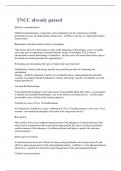
TNCC ALREADY PASSED
Primary concern when a person cannot stop coughing/clearing their throat following house fire/smoke? - Airway/Intubate Lab evidence of cellular perfusion - Base Excess (Less than -6 is BAD) Multiple people are in the ER of different ages who all go to the same church. They all have the same symptoms. What is the most likely cause? - Biologic Suspected shock type with a spinal cord injury - Distributive Shock (Includes neurogenic) Patient has GCS of 3, unequal pupils (one sluggish, one blow...
- Exam (elaborations)
- • 6 pages •
Primary concern when a person cannot stop coughing/clearing their throat following house fire/smoke? - Airway/Intubate Lab evidence of cellular perfusion - Base Excess (Less than -6 is BAD) Multiple people are in the ER of different ages who all go to the same church. They all have the same symptoms. What is the most likely cause? - Biologic Suspected shock type with a spinal cord injury - Distributive Shock (Includes neurogenic) Patient has GCS of 3, unequal pupils (one sluggish, one blow...
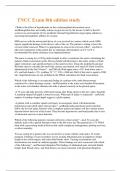
TNCC Exam 8th edition study
1.What is the effect of hypothermia on the oxyhemoglobin dissociation curve - Hemoglobin does not readily release oxygen for use by the tissues A shift to the left occurs in an environment of low metabolic demand (hypothermia, hypocapnia, alkalosis), increasing hemoglobin's affinity for oxygen. EMS arrives with the intoxicated driver of a car involved in a motor vehicle crash. EMS reports significant damage to the driver's side of the car. The patient is asking to have the cervical collar ...
- Exam (elaborations)
- • 6 pages •
1.What is the effect of hypothermia on the oxyhemoglobin dissociation curve - Hemoglobin does not readily release oxygen for use by the tissues A shift to the left occurs in an environment of low metabolic demand (hypothermia, hypocapnia, alkalosis), increasing hemoglobin's affinity for oxygen. EMS arrives with the intoxicated driver of a car involved in a motor vehicle crash. EMS reports significant damage to the driver's side of the car. The patient is asking to have the cervical collar ...
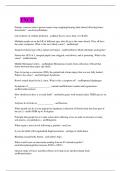
TNCC EXAM RATED A+
1. Preparation and Triage 2. Primary Survery (ABCDE) with resuscitation adjuncts (F,G) 3. Reevaluation (consideration of transfer) 4. Secondary Survey (HI) with reevaluation adjuncts 5. Reevaluation and post resuscitation care 6. Definitive care of transfer to an appropriate trauma nurse - Initial Assessment 1. A- airway and Alertness with simultaneous cervical spinal stabilization 2. B- breathing and Ventilation 3. circulation and control of hemorrhage 4. D - disability (neurologic sta...
- Exam (elaborations)
- • 5 pages •
1. Preparation and Triage 2. Primary Survery (ABCDE) with resuscitation adjuncts (F,G) 3. Reevaluation (consideration of transfer) 4. Secondary Survey (HI) with reevaluation adjuncts 5. Reevaluation and post resuscitation care 6. Definitive care of transfer to an appropriate trauma nurse - Initial Assessment 1. A- airway and Alertness with simultaneous cervical spinal stabilization 2. B- breathing and Ventilation 3. circulation and control of hemorrhage 4. D - disability (neurologic sta...
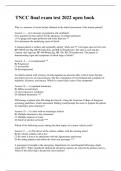
TNCC final exam test 2022 open book
Get a hint Why is a measure of serum lactate obtained in the initial assessment of the trauma patient? Answer: c - a) to measure oxygenation and ventilation b) to quantify the base deficit for the adequacy of cellular perfusion c) *to gauge end-organ perfusion and tissue hypoxia ** d) to determine the underlying cause of shock A trauma patient is restless and repeatedly asking "where am I?" vital signs upon arrival were BP 100/60 mm Hg, HR 96 beats/min, and RR 24 breaths/min. Her skin i...
- Exam (elaborations)
- • 10 pages •
Get a hint Why is a measure of serum lactate obtained in the initial assessment of the trauma patient? Answer: c - a) to measure oxygenation and ventilation b) to quantify the base deficit for the adequacy of cellular perfusion c) *to gauge end-organ perfusion and tissue hypoxia ** d) to determine the underlying cause of shock A trauma patient is restless and repeatedly asking "where am I?" vital signs upon arrival were BP 100/60 mm Hg, HR 96 beats/min, and RR 24 breaths/min. Her skin i...
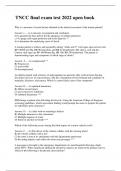
TNCC final exam test 2022 open book
Get a hint Why is a measure of serum lactate obtained in the initial assessment of the trauma patient? Answer: c - a) to measure oxygenation and ventilation b) to quantify the base deficit for the adequacy of cellular perfusion c) *to gauge end-organ perfusion and tissue hypoxia ** d) to determine the underlying cause of shock A trauma patient is restless and repeatedly asking "where am I?" vital signs upon arrival were BP 100/60 mm Hg, HR 96 beats/min, and RR 24 breaths/min. Her skin i...
- Exam (elaborations)
- • 10 pages •
Get a hint Why is a measure of serum lactate obtained in the initial assessment of the trauma patient? Answer: c - a) to measure oxygenation and ventilation b) to quantify the base deficit for the adequacy of cellular perfusion c) *to gauge end-organ perfusion and tissue hypoxia ** d) to determine the underlying cause of shock A trauma patient is restless and repeatedly asking "where am I?" vital signs upon arrival were BP 100/60 mm Hg, HR 96 beats/min, and RR 24 breaths/min. Her skin i...
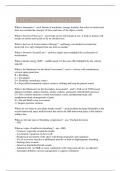
TNCC Notes for Written Exam
What is kinematics? - A branch of mechanics (energy transfer) that refers to motion and does not consider the concepts of force and mass of the object or body. What is Newton's First Law? - A body at rest will remain at rest. A body in motion will remain in motion until acted on by an outside force. What is the Law of Conservation of Energy? - Energy can neither be created nor destroyed. It is only changed from one form to another. What is Newton's Second Law? - Force equals mass multipl...
- Exam (elaborations)
- • 20 pages •
What is kinematics? - A branch of mechanics (energy transfer) that refers to motion and does not consider the concepts of force and mass of the object or body. What is Newton's First Law? - A body at rest will remain at rest. A body in motion will remain in motion until acted on by an outside force. What is the Law of Conservation of Energy? - Energy can neither be created nor destroyed. It is only changed from one form to another. What is Newton's Second Law? - Force equals mass multipl...
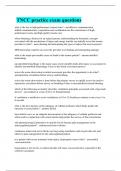
TNCC practice exam questions RATED A+
what is the key to high performance trauma team? - effective communication skilled communication, cooperation and coordination are the cornerstones of high-performance teams and high-quality trauma care when obtaining a history for an injured patient, understanding the kinematic concepts associated with the mechanism of injury and energy transfer can initially assist the trauma provider in what? - evaluating and anticipating the types of injury that may be present MOI and energy transfer c...
- Exam (elaborations)
- • 3 pages •
what is the key to high performance trauma team? - effective communication skilled communication, cooperation and coordination are the cornerstones of high-performance teams and high-quality trauma care when obtaining a history for an injured patient, understanding the kinematic concepts associated with the mechanism of injury and energy transfer can initially assist the trauma provider in what? - evaluating and anticipating the types of injury that may be present MOI and energy transfer c...
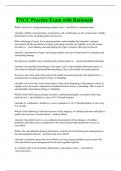
TNCC Practice Exam with Rationale
What is the key to a high performing trauma team? - effective communication rationale: skilled communication, cooperation, and coordination are the cornerstones of high- performance teams and high-quality trauma care When obtaining a history for an injured patient, understanding the kinematic concepts associated with the mechanism of injury and energy transfer can initially assist the trauma provider in: - evaluating and anticipating the types of injuries that may be present rationale: mec...
- Exam (elaborations)
- • 3 pages •
What is the key to a high performing trauma team? - effective communication rationale: skilled communication, cooperation, and coordination are the cornerstones of high- performance teams and high-quality trauma care When obtaining a history for an injured patient, understanding the kinematic concepts associated with the mechanism of injury and energy transfer can initially assist the trauma provider in: - evaluating and anticipating the types of injuries that may be present rationale: mec...

TNCC practice exam
What is the key to a high-performance trauma team? A. Individual goals B. Use of TeamSTEPPS C. Identification of a single decision maker D. Effective communication - D. Effective communication When obtaining a history for an injured patient, understanding the kinematic concepts associated with the mechanism of injury and energy transfer can initially assist the trauma provider in: A. Evaluating and anticipating the types of injury that may be present B. Deciding whether law enforcement s...
- Exam (elaborations)
- • 4 pages •
What is the key to a high-performance trauma team? A. Individual goals B. Use of TeamSTEPPS C. Identification of a single decision maker D. Effective communication - D. Effective communication When obtaining a history for an injured patient, understanding the kinematic concepts associated with the mechanism of injury and energy transfer can initially assist the trauma provider in: A. Evaluating and anticipating the types of injury that may be present B. Deciding whether law enforcement s...
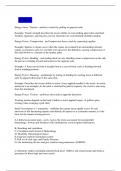
TNCC question and answer already passed.pdf
Energy forces: Tension - ansforces stretch by pulling at opposite ends. Example: Tensile strength describes the tissues ability to resist pulling apart when stretched. Tendons, ligaments, and muscles can tear when they are overstretched (Achilles tendon) Energy Forces: Compression - ansCompression forces crush by squeezing together. Example: Injuries to organs occur when the organs are crushed from surrounding internal organs or structures such as a seat belt worn up across the abdomen, cau...
- Exam (elaborations)
- • 10 pages •
Energy forces: Tension - ansforces stretch by pulling at opposite ends. Example: Tensile strength describes the tissues ability to resist pulling apart when stretched. Tendons, ligaments, and muscles can tear when they are overstretched (Achilles tendon) Energy Forces: Compression - ansCompression forces crush by squeezing together. Example: Injuries to organs occur when the organs are crushed from surrounding internal organs or structures such as a seat belt worn up across the abdomen, cau...
